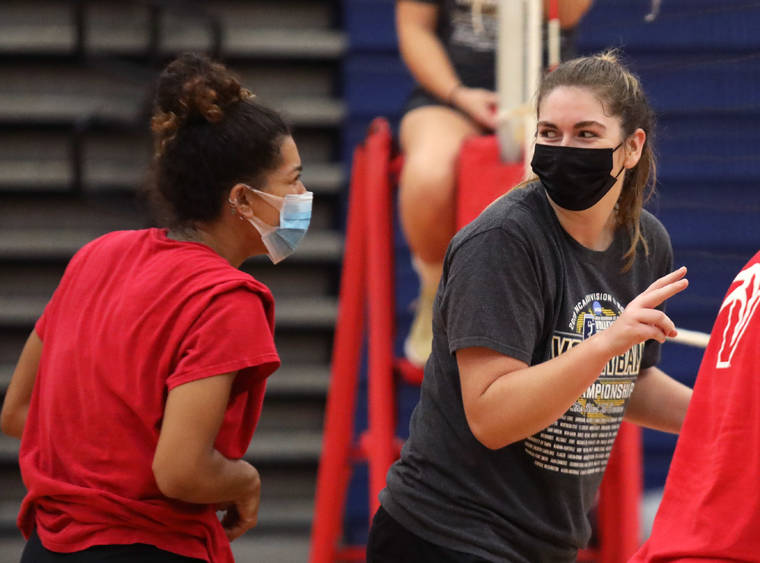The UH-Hilo volleyball team opened practice this week with a bunch of old faces and a couple of transfer weapons looking to conquer the PacWest competition, which seems to keep improving.
It’s the last stand for three returning starters in graduate student outside hitter Bria Beale, senior middle blocker Ashton Jessee, and senior opposite Alex Parisian. The other returning starters are sophomore setter Kendall Kott and freshman libero Tani Hoke.
Sophomore middle Sydney Gott, from Feather River College in California, and sophomore hitter Nicole Schmitz, from the University of Jamestown, an NAIA school, are expected to challenge for starting jobs.
It’ll be a fierce battle for playing time for the rest of the Vulcans who played during the PacWest Hawaii pod spring season. The team went 14-2, but there was no postseason.
“It was good and nice to be back in the gym,” UHH coach Chris Leonard said. “We’ve got a handful of new players coming in that we’re excited about, and great players back. We’re excited to have them back for another year.”
The season opener is on Friday, Sept. 10 against Saint Martin’s in the Hawaii Challenge at McCabe Gym on Oahu. It’s a four-match, three-day tourney, which also includes Cal State East Bay, Saint Martin’s again, and Montana State Billings.
None of the schools are known as powerhouses. The Saints went 1-28 in 2019, the Pioneers were 7-19, and the Yellowjackets went 8-22, underwhelming records compared to the PacWest competition, which starts Sept. 18 against Chaminade at McCabe Gym, followed by Hawaii Pacific a day later at the Shark Tank.
After 10 road matches, the Vulcans finally make their home debut against Biola on Oct. 6. The Urban Knights were 14-8 and sixth in the PacWest in 2019; UHH was 18-4 and the conference runner-up to Azusa Pacific.
“The top half of the league is going to be very challenging,” Leonard said. “For the top six or seven teams, if you play well, you’ll give yourself a chance to win. If not, you’ll lose. There’s more parity than the past couple of years. Overall, the play amongst the conference is the highest I’ve seen.
“Kahala (Kabalis-Hoke, Chaminade’s coach) graduated a big class last year. She’s got a very nice class going in. She added some nice pieces. The Hawaii road trip will be tough for a lot of mainland teams.”
Leonard is fully aware it’s the last stand for his three seniors, especially Beale, a Division I transfer from UC Irvine. He already went on a recruiting trip during the offseason to look for the next batch of Vulcans for the 2022 and 2023 classes.
“With college teams, it’s an ongoing process,” he said. “You graduate talented players and continue to bring in more talented players. Someone like Bria is not easy to replace.
“We have some players we have an eye on but can’t sign them to a NIL (national letter of intent) until November. We’ve got some kids who we really like their potential and think they could be great Vulcans and extraordinary players. At the end of the day, it’s a big step up from high school to college.”
Leonard pointed out it’s a misconception to rank players and put them in a shoebox, such as Division I, II, III, NAIA, and junior college or think that the higher the level, the better the player. He believes the tougher Division II teams could compete with mid-level Division I programs.
Then there’s the NCAA transfer portal, the newest player acquisition tool. It’s the easiest way to restock a roster.
“For us, we’ll look at the portal. The one thing is to have class balance. You don’t want everyone graduating all at once,” Leonard said. “You don’t want to go through that proverbial rebuilding year. That’s the value of junior college transfers. They come in with experience.
“We want to bring the best talent in the gym. We’re looking to recruit good team culture kids. We’re looking everywhere to find them.”

